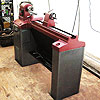Hi Folks,
The other day I had to make a difficult cut angled cut. Things went fine, but I found myself wondering if there was an easier (or safer) way.
The first picture shows the board after I made the cut. Note that I needed to cut it at a 24 deg angle. If I had tried to cut the board lying flat, I would have needed to cut it at a 66 deg angle, beyond what a tablesaw could handle, so I decided to cut it vertically.
I started with "Plan A" (2nd picture). It basically involved tilting the blade to the 24 deg position, using a sacrificial fence, and a featherboard. I lined up the fence so that just a little bit would be left on the bottom of the board (3rd picture). To increase my safety, I used a clamp riding on the fence to hold the workpiece as I moved it into the cut. (4th picture). The 5th picture shows a close up.
(continued)




 Reply With Quote
Reply With Quote




